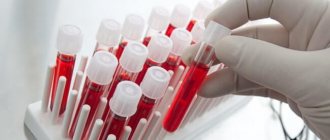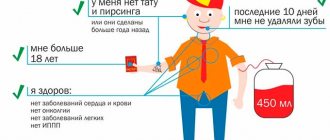Donor blood and its components have a limited shelf life and are constantly required. It is impossible to do without them during complex operations, childbirth, treatment of severe injuries and burns, massive blood loss, anemia, sepsis, blood diseases and other pathologies.
Being a donor is an honorable and noble thing, but not everyone can become one. The rules for donating blood, its procurement, storage, and transportation are established by the law “On the Donation of Blood and Its Components.” It is designed to ensure the safety of blood transfusions and protect the health of not only the recipient, but also the donor.
Health
Good health at the time of blood donation.
You should not donate blood if you have a cold, flu, sore throat, herpes, upset stomach or any other infection.
You cannot donate blood for 6 months after getting a tattoo or piercing. If the piercing was performed by a registered healthcare professional and there is no inflammation, you can donate blood after 12 hours.
After visiting the dentist for a minor procedure, you can donate blood within 24 hours; After significant interventions, you must wait a month.
You cannot donate blood if your hemoglobin levels are below the minimum level established for blood donation:
- A test is performed at the blood donation site. In many countries, minimum hemoglobin levels are 12.0 g/dL for women and 13.0 g/dL for men.
Why should I donate blood? Aren't there enough donors already?
In Russia, only 1.7% of the population are donors.
In order to ensure an adequate supply of blood, it is necessary that at least 4% of the population be donors. Many people are not suitable for donation due to contraindications, since the blood must be safe for patients. Donors can only be healthy people over the age of 18. The Hematology Research Center is constantly in need of whole blood donors, plasma donors, platelet donors, and stem cell donors. The Center undergoes long-term treatment for cancer patients for whom blood and its components are vital. Without them, they simply will not be able to survive after immune-lowering doses of chemotherapy.
What is the state of blood donation now?
In Russia, there are less than half of the donors than there should be in order for the needs of hospitals to be covered. This is why it is necessary for donors to donate blood regularly. In addition to major tragic events (terrorist attacks, fires, etc.), there is a constant need in modern medicine for components and products of donor blood, because almost any area of it now cannot do without the use of transfusion therapy (surgeries, hematology, emergencies, road accidents, women in labor, children, oncology and etc.).
Do I have enough blood to share?
An adult has 4-5 liters of blood. During blood donation, 450 ml of blood is taken - this accounts for 8% of all blood, which is restored within 72 hours. Drainage is completely safe and stimulates the immune and hematopoietic systems.
How long does the blood donation procedure take?
When you go to donate whole blood, expect 1 hour 10 minutes. This is how much time it will take you to fill out the form, undergo a medical examination, and rest after donating blood. Donating whole blood takes only 5-10 minutes.
If you donate plasma, you will spend 1 hour 40 minutes, including 40 minutes on the plasma donation procedure itself.
The entire process of donating platelets will take you 2 hours 30 minutes, including 1 hour 30 minutes for the donation itself.
How are donors selected?
All donors undergo a medical examination before each blood donation. At this time, a clinical analysis of capillary blood from a finger is carried out, a thorough interview with a transfusiologist, who reviews the questionnaire filled out by the donor and, based on the donor’s health condition and the results of the analysis, determines whether the person is suitable for donation. It is very important that the donor who fills out the questionnaire answers the questions asked objectively.
All information about the donor is confidential.
But there are well-known contraindications to donation, temporary and permanent, which we recommend that those wishing to become a donor familiarize themselves with.
Can I get a viral infection while donating blood?
Infection of a donor during blood donation is impossible, since his blood does not come into contact with the blood of another person, and during the procedure, disposable sterile needles and bags and blood collection instruments are used, which completely exclude the possibility of interaction of the donor’s body with the external environment.
The platelet donation procedure (plateletpheresis) uses a closed, disposable system where the plateletpheresis machine is charged immediately before each donor.
Only highly qualified medical specialists from the donor service with many years of experience work with donors.
Why do you need to rest after blood donation?
Each donor should rest for at least 10 minutes after donating. Even if you feel fine after donating, drink juice, tea, water or coffee. This helps replenish fluid loss in the body. If you feel weak after donating blood, the experienced staff at the donor service will be able to help you quickly.
I don't remember the last time I donated blood. How do I find out?
This information can be clarified at the donor department of the National Medical Research Center for Hematology on weekdays from 9:00 to 17:30 by phone:
+7 +7
What will they do with my blood?
The blood of each donor is thoroughly examined. First, the blood group according to the AB0 system, Rh and Kell affiliation are determined. This is necessary so that the patient receives the blood component that suits him. Testing for blood-borne infections and syphilis is then performed to ensure safe transfusion.
Whole donor blood is not used. Each dose of blood is divided into red blood cell suspension and plasma. The patient receives exactly the component he needs. Thus, the blood of one donor can save the lives of several patients.
Red blood cell suspension is used during routine operations, for blood loss, trauma, and to treat anemia.
Plasma is used for liver disease, blood loss, to treat blood clotting disorders, and to treat shock.
Is it possible to purchase (purchase) blood and its components from you?
Blood and its components cannot be purchased.
Blood taken from donors at the Hematology Research Center is used exclusively for patients of the Center.
Is there a blood substitute?
Blood is a unique organic material that cannot be artificially produced. The only source of blood is the donor.
What will I get for donating blood?
The donor who donated blood (components), first of all, will receive monetary compensation for food in the amount of 5% of the established subsistence level, 2 days off at the place of work (on the day of donating blood and any other day of his choice within a year after donation), and also high self-esteem from the knowledge that you have helped other people.
In addition, the donor will have constant monitoring of his health.
Is my employer required to let me go from work while I donate blood?
Yes, according to the Law of the Russian Federation “On the donation of blood and its components” dated July 20, 2012 No. 125-FZ and the Labor Code of the Russian Federation (Art. 186).
How often can you donate blood and its components?
There are different types of donation: whole blood donation and component donation.
Whole blood is allowed to be donated no more than 5 times a year for men and no more than 4 times a year for women, and the intervals between blood donations must be at least 60 days.
Certain blood components can be donated more often. The intervals between different types of donation of blood components are indicated in the table (read more).
When donating plasma, you are allowed to donate a total of no more than 12 liters of plasma per year.
As for plateletpheresis, the donor is allowed to donate platelets no more than once a month. This is due to the fact that the National Medical Research Center of Hematology uses hardware plateletpheresis, in which the dose of platelets taken at a time is greater than with intermittent (read more).
How is donating blood different from donating plasma and donating platelets?
When donating plasma, blood, after part of the plasma is separated from it, is immediately returned back to the donor’s body. When donating platelets, only platelets are separated from the donor blood, and the remaining components are returned to the donor.
Isolation of plasma and platelets from the blood occurs by passing donor blood through a special apparatus with a closed disposable centrifugation system.
Plasma can be donated at intervals of at least 2 weeks, no more than 12 liters per year, whole blood - no more than 5 times a year at intervals of 2 months, platelets - 12 times a year at intervals of 1 month.
After five regular blood donations, it is better to take a break for 3-4 months. Plasma is restored within a few days, blood within a month.
The process of donating platelets takes about 1.5 hours, plasma - about 40 minutes, blood sampling - about 10-15 minutes. However, the total time that the donor will need to spend in a medical facility will be 2.5 hours in the first case, 1 hour 40 minutes in the second case, and 1 hour 10 minutes in the last case.
Can a smoker be a donor?
Smoking is not a contraindication to donation. Experts recommend refraining from smoking an hour before the blood donation procedure and not smoking for one to two hours after donation.
What should you do to restore your body after donating blood?
On the day of blood donation, heavy physical and sports activities and heavy lifting are not recommended. There are no restrictions on driving a car on the day of blood donation.
For two days, it is recommended to eat well and regularly, drink at least 1-2 liters of liquid per day (alcohol is not recommended).
Then lead your normal lifestyle.
Complete restoration of blood composition occurs within 5-7 days. The rate of recovery of different blood components is different. To restore your blood composition faster, it is recommended to drink more fluids: juices, tea. Proper nutrition is necessary: the donor’s diet should always contain protein, which determines the level of hemoglobin in the blood, as well as foods high in iron and calcium.
Do regular blood donors have to use their blood donation vacation days during the calendar year?
In accordance with Article 186 of the Labor Code of the Russian Federation, after each day of donating blood and its components, the employee is given an additional day of rest. The specified day of rest, at the request of the employee, can be added to the annual paid leave or used at other times during the year, after donating blood and its components.
In the previous version of this article, the employee’s right to use an additional day of rest after donating blood was limited to the calendar year (from January 1 to December 31), which infringed on the interests of donors. Moreover, in a number of cases, namely when donating blood in the last days of the calendar year, it was not possible to implement it.
In accordance with the amendments made to the Labor Code by Federal Law No. 90-FZ of June 30, 2006, the word “calendar” was excluded from Article 186. Thus, donors can use the additional day of rest they are entitled to within 365 days after donating blood.
Are the actions of an employer legal when it refuses to provide days to an employee-donor, citing the fact that he donated blood before he had yet joined the organization?
The legislation of the Russian Federation does not contain a direct answer to the question posed. On the one hand, the provision of unused additional days of rest provided for in Part 4 of Art. 186 of the Labor Code of the Russian Federation, for a new place of work (with another employer) is not provided for by law.
On the other hand, Art. 186 of the Labor Code of the Russian Federation does not in any way limit the donor’s right to use rest days only at the previous place of work, however, this position may lead to a labor dispute with the employer, which will have to be resolved in the bodies for considering individual labor disputes (Chapter 60 of the Labor Code of the Russian Federation).
How can I confirm my right to the title “Honorary Donor”?
Thanks to the unified donor registration system being created in our country, all donations are recorded in the databases of Blood Service institutions; the data must be stored there for many years.
Please note that to obtain the right to be awarded the “Honorary Donor of Russia” badge, only gratuitous donations are taken into account.
Is it possible to become an “Honorary Donor of Moscow”?
No, the “Honorary Donor of Moscow” badge is provided only by blood service institutions subordinate to the Moscow Department of Health. The Hematology Research Center is an institution subordinate to the Russian Ministry of Health, from us you can receive the “Honorary Donor of Russia” badge.
Is it possible to be a donor to a nursing mother?
Today, one of the temporary contraindications is the period of pregnancy and lactation. 1 year must pass after birth and 3 months after the end of lactation.
Can the presence of Kell (+) antigens in the blood become a disqualification for donation?
The presence of Kell (+) antigens in the donor's red blood cells does not mean that a person cannot become an active donor.
If such an indicator is present in the blood, he can be a donor of plasma and platelets.
Read more about Kell accessories at this link.
Is it possible to become a donor if a close relative has inactive chronic hepatitis B?
In this situation, the person is a contact person with a hepatitis patient and must be exempted from donation.
What causes a citrate reaction?
When donating platelets, in order to avoid blood clotting when it passes through a centrifuge to separate platelets and plasma from it, sodium citrate (sodium citrate trisubstituted 2-aqueous) is used.
The citrate reaction is the body's reaction to intolerance to sodium citrate.
Therefore, regular platelet donors should try to donate platelets once every two to three months, as well as take calcium vitamins after donation and follow nutritional recommendations (read more).
Chylosis is a blood disease?
Chylosis is not a disease, but a condition that indicates the presence of triglycerides in the blood - fatty particles (neutral fats) that do not allow for an accurate diagnosis. Normally they should not be in the blood. After centrifugation, such blood becomes white and very thick, resembling sour cream in appearance.
The reason for the high level of neutral fats and the formation of chylous serum is improper preparation for blood collection, when alcohol or fatty foods are consumed by the donor before donation.
Chylous serum does not make it possible to isolate blood components. Therefore, a blood test cannot be performed. It is also impossible to use “fat” blood for transfusion to the recipient.
After 10-12 hours, the level of triglycerides in the blood decreases to the initial level.
Find out how to feed your donor properly.
How long after donation can workers in hazardous industries return to work?
If you work in a hazardous industry, the interval between donation and going to work should be at least 12 hours.
Can donations for which compensation for food were paid be considered gratuitous? Will they be considered for the Honorary Donor designation?
All donations after which you received only monetary compensation for food will be taken into account when receiving the “Honorary Donor of Russia” badge.
Donors who donate blood and/or its components (except for blood plasma) 40 or more times or blood plasma 60 or more times are awarded the “Honorary Donor of Russia” badge.
Also, amendments introduced by Article 61 of the Federal Law of November 25, 2013 No. 317-FZ “On amendments to certain legislative acts of the Russian Federation and invalidation of certain provisions of legislative acts of the Russian Federation on issues of protecting the health of citizens in the Russian Federation” to Article 23 of the Federal Law dated June 20, 2012 No. 125-FZ “On the donation of blood and its components”, established the most optimal formula for calculating quantitative criteria for achieving the right to award in cases of mixed donation.
Now, if a donor has, for example, twenty-five or more free donations of whole blood behind him, and then began donating plasma free of charge, the right to an award will come with a total number of donations of 40 times.
If a donor has switched to the category of plasma donors, having previously donated whole blood less than 25 times free of charge, then in order to receive the right to be awarded, he will need to continue to donate free plasma until he reaches a total number of donations of 60 times.
The law stipulates that the donation of any cellular component (erythrocytes, platelets or granulocytes) is equivalent to the donation of whole blood. Read more.
Trips
Travel to areas where mosquito-borne infections such as malaria, dengue, and Zika virus infections are common may require temporary abstinence.
Many countries are temporarily preventing people who have traveled to or resided in specific countries or areas during certain periods of cumulative exposure from donating blood as a measure to reduce the risk of transmission of variant Creutzfeldt-Jakob disease through blood transfusions.
Contraindications to donation
Contraindications can be absolute or temporary. Persons suffering from certain diseases and carriers of pathogens of certain diseases cannot become donors. These include:
- viral hepatitis;
- tuberculosis;
- syphilis;
- HIV and AIDS;
- blood diseases;
- oncological processes;
- parasitic diseases (toxoplasmosis, etc.);
- alcoholism and drug addiction;
- mental illnesses and organic disorders of the central nervous system;
- cardiovascular pathologies: ischemic heart disease, heart defects, hypertension, atherosclerosis and others;
- bronchial asthma;
- severe diseases of the kidneys, visual organs (blindness) and ENT organs (lack of hearing, speech);
- skin diseases: psoriasis, furunculosis, eczema, fungal infections and others;
- lupus erythematosus;
- gastrointestinal diseases: stomach ulcers, liver cirrhosis and others;
- high myopia;
- osteomyelitis;
- radiation sickness;
- operations to remove or transplant organs.
Temporary contraindications include certain conditions, as well as recent diseases and procedures:
- flu, sore throat, ARVI;
- vaccination (must be at least 30 days after the procedure);
- piercing, tattoo, permanent makeup;
- abortion;
- menstruation (a week after its end);
- pregnancy (no earlier than a year after the birth of the child) and breastfeeding (no earlier than three months after the last feeding);
- allergies in aggravation;
- tooth extraction (no earlier than a week);
- surgery;
- taking analgesics (must last three days) and antibiotics (at least two weeks);
- long-term residence in tropical and subtropical areas.
Behavior
You cannot donate blood:
- after "risky" forms of sexual activity in the last 12 months
- The following persons are not allowed to donate blood under any circumstances:
- persons who have ever tested positive for HIV infection
- persons who have ever used injecting psychoactive substances.
National blood donor selection guidelines include additional behavioral eligibility criteria. These criteria may vary from country to country.
How to prepare?
Every donor should know what rules must be followed before donating blood. A number of requirements must be met. Typically, future donors receive the following advice:
- Two days before the procedure you should not drink alcohol.
- Smoking is not allowed two hours before the test.
- For three days before the procedure, you should not take medications with analgin, aspirin, or other thinning medications.
- On the eve of the procedure, you need to eat right, that is, avoid fatty, spicy, fried, smoked foods, as well as dairy products, bananas, citrus fruits, butter, eggs, and nuts.
- It is recommended to eat vegetables, fruits, cereals, bread, jam, pasta, crackers, and steamed fish. You can drink mineral water, sweet tea, juice, compote, fruit drink.
- In the morning on the day of delivery, you must have breakfast; it is not recommended to undergo the procedure on an empty stomach. A proper breakfast should look something like this: buckwheat, rolled oats or rice porridge in water with the addition of honey, dried fruits or fresh fruits, sweet tea with crackers or a piece of white bread with jam.
- You cannot go to a transfusion center as a donor after a sleepless night, for example, after a night shift. You need to show up well rested.
- You should not take it during a period of intensive work (on the eve of the exam).
During the procedure, the donor is in comfortable conditions in a comfortable chair
Pregnancy and breastfeeding
After pregnancy, the period of abstinence from blood donation should be as many months as the pregnancy lasted.
It is not recommended to donate blood while breastfeeding. After birth, the period of abstinence from blood donation is at least 9 months (according to the length of pregnancy) and lasts 3 months, during which the baby is largely weaned (that is, receives most of its nutrition in the form of solid foods or formula) .
Who can donate blood?
You can become a donor only on a voluntary and free basis. This is a person of any gender from 18 to 60 years old, who has been examined and has no contraindications. The donor's body weight cannot be less than 50 kg.
According to the new law of the Russian Federation “On Blood Donation,” which came into force in 2012, not only Russians, but also foreign citizens who have been in our country legally for at least a year have the right to donate blood.
Women are allowed to donate no more than four times a year, men - no more than five times, and the time interval between whole blood collections must be at least 60 days. In the case of donating blood components, this period is 30 days.
Where can I donate plasma?
Most often, blood transfusion stations do not accept plasma donors; you must contact large clinics or institutes. Plasma is also accepted by central hospitals and clinics that specialize in treating trauma patients.
When donating whole blood, you usually only need a passport and registration, but you can donate blood for plasma only after undergoing an outpatient examination. In this case, the donor independently makes an appointment with the doctor and brings the necessary certificates - as a rule, this is the conclusion of an infectious disease specialist, therapist and gynecologist (for women). This is not always practiced - the exact information needs to be clarified at the clinic where you are going to donate blood or plasma.
The benefits and harms of plasma donation
In modern clinics, only sterile equipment is used to collect plasma, and donors are examined before the procedure, so the process of donating plasma does not pose a health risk. But it must be remembered that this is an invasive manipulation that always has certain consequences for the body.
Plasma is the liquid component of human blood, which occupies 52-60 percent of the total volume circulating through the vessels. 40-48 percent are occupied by red blood cells (erythrocytes) and white blood cells (leukocytes).
Plasma contains a high protein content of 60-85 grams per liter; they perform nutritional, transport, and immune functions. It is thanks to plasma that amino acids, lipids, gamma globulins, glucose, vitamins, and microelements circulate.
How is the procedure done?
- At the reception, you must fill out a questionnaire in which you report on your habits, lifestyle and general health.
- In the laboratory you need to take a finger test to determine the main indicators (leukocytes, hemoglobin, etc.), blood type and Rh factor. They check for syphilis, hepatitis, and HIV.
- The general practitioner examines the questionnaire, asks additional questions if necessary, conducts a visual examination and decides whether the person can be a donor on that day.
- Before donating blood, you need to visit the buffet and drink sweet tea with a bun or juice.
- The donor sits in a comfortable chair (you can donate blood while sitting, reclining or lying down), the arm above the elbow is tightened with a rubber band, and the skin is treated with a disinfectant. During the procedure, only disposable instruments are allowed to be used. 450 ml of blood is drawn from a vein (if it is whole blood). The blood or components are collected in a special bag, which is connected to the needle with a thin tube. Some of the blood will go for analysis. Upon completion, a bandage is applied to the elbow for 4 hours. The duration of the procedure is about 10 minutes.
- The donor receives a certificate stating that he donated blood. Then he is given lunch and rest.
It should be said that blood sampling can be carried out according to different schemes. In the first case, whole blood is taken, and in the future it is used at the discretion of doctors. In addition, it is not whole donor blood that is transfused, but some of its components (plasma or platelets). In this case, the procedure is quite complicated.
The blood is collected in a special container, which is connected to the needle by a thin tube
A thorough examination is necessary before donating platelets. Platelets are taken in two ways: instrumental and intermittent. In the first, blood is drawn continuously, with both hands involved: blood is taken from one and immediately poured into the other. With the intermittent method, a portion is taken, the platelets are separated from it, the remainder is infused into the donor, then the next portion, and so on. By law, it is prohibited to donate platelets multiple times due to the complexity of the procedure for donors.
Donating plasma is similar to the process with platelets, but uses different equipment and does not require testing. During collection, the plasma is separated and most of the blood is returned to the donor.
Why being a donor is not harmful
A donor who donates a decent portion of material may not worry about his health for the following reasons:
- Donating the amount of blood required by law is not at all dangerous for a healthy person.
- After donation, the person is under the supervision of medical personnel and can receive qualified assistance at any time, but, as a rule, most people who have chosen to donate tolerate the procedure normally.
- The law provides for the provision of free food and paid days necessary for recovery.
The importance of plateletpheresis
Platelets are one of the components of blood that protects the body from bleeding. Damage to blood vessels causes the blood platelets to stick together with the subsequent formation of a blood clot, clogging the damage and preventing blood loss.
Anucleate bodies stimulate hemostasis, participate in the delivery of nutrients to the endothelium, and also promote tissue healing and restoration by releasing growth factors.
An increase in platelet count is required for patients suffering from platelet deficiency caused by:
- thrombocytopenia (low concentration of blood platelets in the blood);
- thrombosthenia (hereditary pathology, accompanied by dysfunction of platelets when their number is normal);
- DIC syndrome (impaired blood clotting);
- local bleeding (uterine, gastric, etc.);
- heavy blood loss during surgical interventions;
- frequent nosebleeds or blood discharge from mucous membranes.
Thrombocytopheresis is also prescribed when there is an increased content of platelets in the blood in order to reduce their concentration and reduce the risk of blood clots.
The level of platelets can be determined using a general blood test prescribed by the attending physician in the presence of certain symptoms (increased bleeding, the appearance of hemorrhages on the body for no reason, etc.). In some cases, donating venous blood is advisable. The procedure is safe and is performed in most clinics.
Platelet mass is also necessary for the manufacture of blood substitutes and some medicines.










